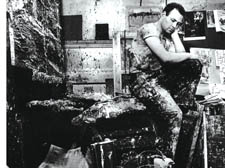|
|
 |
| |

Frank Auerbach in his studio, by
Jorge Lewinski. |
Deconstructing the building game
After fleeing Germany, enigmatic Camden Town artist Frank Auerbach built a career observing the capital as it got back on its feet from the ruins of bomb sites, writes Gerald Isaaman
A HUGE white crane hangs, almost appropriately, over historic Somerset House in the Strand, as if to highlight an extraordinary exhibition at present on display below the cupola on the top floor of the Courtauld Gallery.
A peep into the gallery and a half is hardly enticing for the uninitiated visitor. For, apart from the painting facing them as they enter, they see huge canvases in muddy blacks and browns, dark greens, spluttering yellows and the odd red steel girder reaching for the sky.
It’s like walking into a tunnel, a cave, a pit and having to adjust your eyesight to the earthworks, the sombre shades, trying to make out the workmen amid new buildings rising from the ruined rubble of post-war London bomb sites.
You may get lost among the wriggling worms but the overall effect, incredibly, is an emphatic form of raw creation, the paintings telling the story of how the capital was reborn following the destruction of the 76 nights of the 1940 Blitz.
That is when 80,000 buildings ended up as wrecks, another 700,000 damaged and some 80,000 people either killed or maimed.
Yet for Frank Auerbach, a young artist who escaped to Britain from Hitler’s Berlin as boy, it was “the beginning of my life as a painter”. And as planning controls were swept away to create a boisterous building boom, he sketched and painted vital sites such as the South Bank, the Empire Cinema, Leicester Square, and the John Lewis department store, in Oxford Street.
Local ones too, such as the Regent’s Park housing estate, Maples, in Euston Road, now brought together from his days observing a bomb-scarred city which he describes as “a marvellous landscape with precipice and mountain and crags, full of drama…everything rather used and worn and unpainted and grubby...it seemed mad to waste the opportunity.”
It takes time and patience to penetrate them. For Auerbach’s technique is to build his landscapes with layer upon layer of paint poured on to board, then gouged and, more so today, scraped away and replaced with yet more paint, in an exercise of enormous controlled energy.
He has been doing it for years now at his studio in Camden Town, where his obsession with his work, like his fellow Jewish artist Lucian Freud, is his life, the end product in any year but a handful of paintings.
It is a small, simple, structured, reclusive world he lives in. And, despite the million-pound prices his works fetch, he has no popular reputation.
It is a shame in many respects. Once you grasp the magnitude of his work, the Rembrandt-inspired crucifix in his Shell Building Site from the Thames, 1959, the tangle of beams, cranes and ladders, the subtle use of colour and texture as he excavates the world on his doorstep, you feel you want to know him. And need to shout questions.
Alas, he rarely answers the door. And the only picture of him in the show is by Jorge Lewinsky, from 1963. It shows unsmiling Auerbach looking like a sculptured Thinker, standing virtually asleep and self-imprisoned in his beloved studio.
• |

|
 |
| |
|
 |
|

